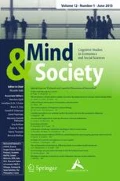Abstract
The goal of the paper is to analyse some specific features of a very central concept for top-level ontologies for information systems: i.e. the concept of artefact. Specifically, we analyse the relation to be a copy of that is strongly linked to the notion of artefact and—as we will demonstrate—could be useful to distinguish artefacts from objects of other kinds. Firstly, we outline some intuitive and commonsensical reasons for the need of a clarification of the notion of artefact in ontologies for information systems, and we analyse some characterisations of the notion given by two top-level ontologies (Cyc and Wordnet). Secondly, we introduce and critically analyse Tzouvaras’ notion of copy. Thirdly, we try to complete an analysis of copy by distinguishing three kinds of copies: replicas (Tzouvaras’ notion of copy), rigid copies, and functional copies. With the help of these three notions we outline a first and preliminary distinction between artefacts, objects of art and natural objects.
Similar content being viewed by others
Notes
For an overview of Cyc and Wordnet see: http://www.cyc.com and http://www.cogsci.princeton.edu/∼wn/.
See: http://www.cyc.com; record: "artefact".
In Tzouvaras (1995).
Tzouvaras 1995, 464.
Tzouvaras 1995, 458.
It is important to keep in mind that the aim of the paper is not to give a definition of artefacts in terms of necessary and sufficient conditions. The aim of the paper is to characterize artefacts through the relation between the notion of copy and that of artefact. Hence, even if we qualify copies of this type as artefacts we do not run the risk of circularity.
There are cases that at a first glance can seem counterexamples. Take for example the case of xylography; we might be tempted to consider them as replicas of one another. But the point is that if we accept them as replicas of one another, given the above definition, we are forced to accept that they are always intersubstitutable, and this seems clearly false. Most of the time they are numbered one by one, other times they are different in colours or other particulars, and this seems to imply that generally they are not considered totally equivalent to one another. They clearly cannot even be considered as copies or replicas of the original masterpiece.
This does not mean that it has to be possible in all circumstances, most of the time substitutability is constrained by use. For example, take the famous puzzle of the Theseus' ship [a formulation of the puzzle is, for example, in Wiggins (2001, 161–162)]. The ship made of original planks cannot be simply substituted by a copy of it made of new materials if we want to put it amongst the objects of an antique collector. But, obviously, for other uses—like sailing—it can be substituted by one of its copies. In some circumstances the substitution seems possible even for objects of art. For example, if I am a thief, I can substitute the original piece in the museum, with a copy of it and steal it. But this does not amount to a real substitution—that is when the original object and the copy are considered as completely interchangeable objects—and it is precisely in this lack of interchangeability that the reason lies for the thief to steal the object.
References
Gibson JJ (1966) The senses considered as perceptual systems. Allen and Unwin, London
Gibson JJ (1979) The ecological approach to visual perception. Houghton Mifflin, Boston
Guarino N (1998) Semantic matching: formal ontological distinctions for information organization, extraction, and integration. In: Pazienza MT (ed) Information extraction. Springer, Heidelberg, pp 139–170
Pustejovsky J (1998) Lexical semantics and formal ontologies. In: Guarino N (ed) Formal ontology in informations systems. IOS, Amsterdam, pp 328–333
Thomasson A (1999) Fiction and metaphysics. Cambridge University Press, Cambridge
Thomasson A (2003) Fictional characters and literary practices. Br J Aes 43:138–157
Tzouvaras A (1993) Significant parts and identity of artefacts. Notre Dame J Form Log 34:445–452
Tzouvaras A (1995) World of homogeneous artefacts. Notre Dame J Form Log 36:454–474
Uschold M, Gruninger M (1996) Ontologies: principles, methods and applications. Know Eng Rew 11:93–136
Wiggins D (2001) Sameness and substance renewed. Cambridge University Press, Cambridge
Acknowledgments
This article is a revised version of the paper presented at the Second European Conference Computing and Philosophy (E-CAP2004), held at the University of Pavia, Italy (June 3–5, 2004) and chaired by Lorenzo Magnani. We are indebted to the participants of the conference for the stimulating discussion. Thanks also to Francesco Berto, Cristiana Bettella, Gillian Davies, Pierdaniele Giaretta, Vittorio Morato, and to the referees of Mind and Society for their detailed comments to earlier versions of this paper.
Author information
Authors and Affiliations
Corresponding author
Rights and permissions
About this article
Cite this article
Carrara, M., Soavi, M. Ontology for information systems: artefacts as a case study. Mind Soc 7, 143–156 (2008). https://doi.org/10.1007/s11299-007-0036-4
Received:
Accepted:
Published:
Issue Date:
DOI: https://doi.org/10.1007/s11299-007-0036-4



